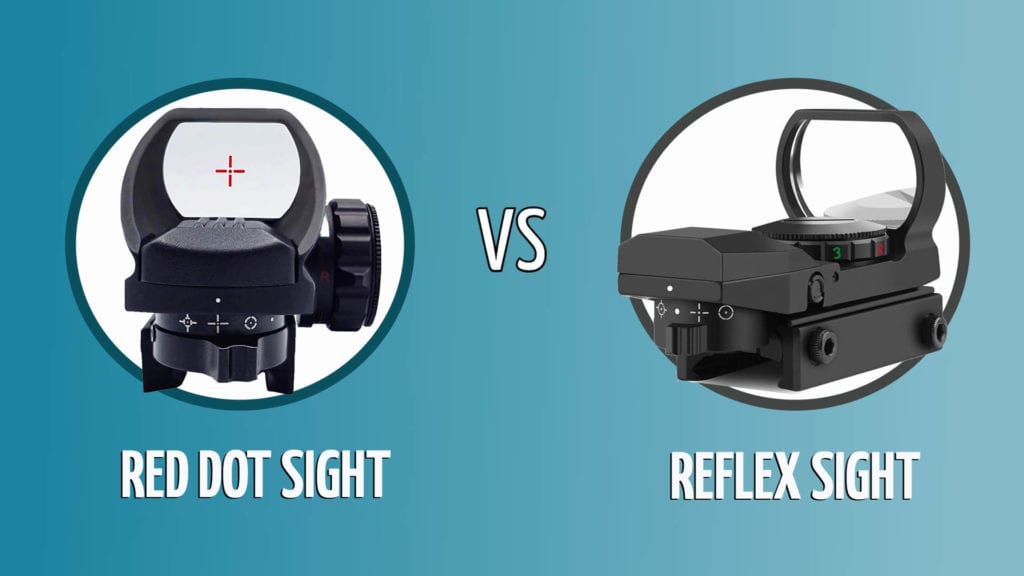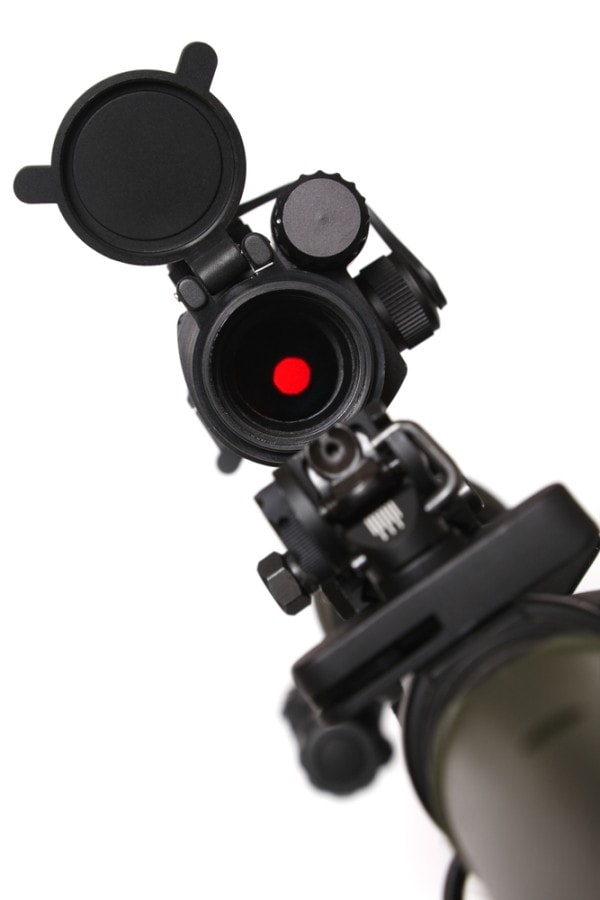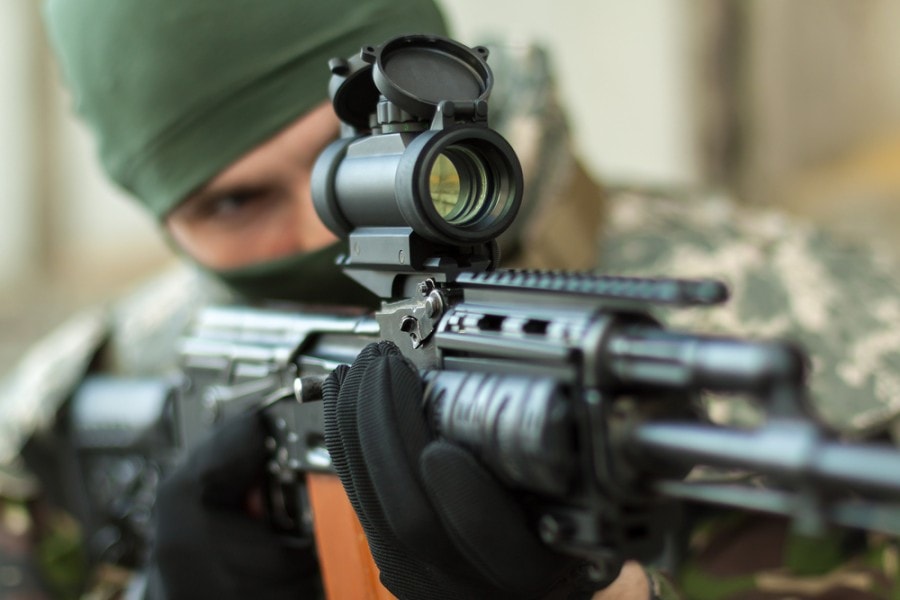Red Dot vs Reflex Sights: What’s the Difference?
Last Updated on

It’s a common question; red dot vs reflex sights, what’s the difference? And which is better? If you’re asking this question, then the truth may surprise you. There are several different types of red dot sights, including reflex sights. So, all reflex sights are red dot sights, but not all red dot sights are reflex sights.
Now that we’ve established that reflex sights are a variation of red dot sights, it begs the question; what are red dot sights and reflex sights? By the end of this article, you’ll know exactly what each of these types of sights is, what they do, and which is best for you.
What is a Red Dot Sight?

As we said, there are several different types of red dot sights. Red dot sights are a broad category that encompasses all sights that use a red dot as your aiming reticule. Prism sights, holographic sights, and reflex sights are all different types of red dot sights.
Of course, red dot is a generalized term as well. Many of these sights use a green dot or even some other shape with no dot at all! But it’s some type of illuminated electronic image that provides your aiming point.
- Many types of red dot sights to choose from
- Illuminated electronic image provides your aiming point
- Some types have small eye reliefs
- Some red dot sights can be very expensive
What is a Reflex Sight?

A reflex sight is one of the three main types of red dot sights. This type of sight is named because a small light is projected from the rear of the scope which the front lens reflects back as the red dot for you to aim with.
There are two types of reflex sights: tube sights and exposed reflex sights.
An exposed reflex sight has only a single lens that’s positioned to the front of the scope. This lens reflects back the dot that you see. Since it’s wide open with no eye relief, you can acquire your target very quickly with this type of sight.
A tube reflex sight has two lenses and looks more like a traditional small scope. The light is projected from the rear lens and reflected by the front lens. There is still no eye relief with this type of reflex sight. It’s easier and quicker for acquiring targets than most traditional sights, though not quite as fast as the exposed reflex sight.
Reflex sights tend to be lower-cost than other types of red dot sights. But they’re not magnified, so they’re mostly useful for shooting in close quarters. Because there’s no eye relief, you can shoot with both eyes open and your head anywhere and still get a clear image, which is the major advantage to this type of sight.
- Can be battery-free
- Tend to be low-cost
- Very quick to acquire your target
- Not magnified
Other Types of Red Dot Sights
Like we’ve mentioned, there are three main types of red dot sights. Reflex sights are only one, but there are still prism sights and holographic sights that are different from reflex sights, though they still fall under the red dot sight umbrella.
Prism Sights
Prism sights look like more compact versions of traditional rifle scopes. They have a standard tube-style design, but they use prisms instead of multiple lenses to focus the image. This is how they achieve such a small size. Of course, they also only come with lower levels of magnification to match the smaller size.
Another drawback of the small size is the very small eye relief. You must be very close up to this type of sight if you want to get a clear picture. It’s great for shooting at moderate distances and farther, but not the best for shorter-range shooting because of how slow they are for reacquiring your target.
Holographic Sights
These rectangular sights have a field of view that matches their shape with a tiny aiming reticle that’s great for precise shooting. Because of the wider field of view, you can aim with both eyes open and acquire targets very quickly.
This type of sight uses a laser and a series of mirrors to provide your red dot aiming point. It’s a powerful red dot sight that has some of the fastest target acquisition out of them all. Unlike other types of red dot sights, the reticule in a holographic sight will remain in focus while you look downfield outside of the scope. This makes it much faster to reacquire your target inside the scope.
One of the coolest features of a holographic sight is that they can still function even if the front lens is damaged. With other types of red dot sights, if the front lens is damaged, the sight will no longer work.
The only real drawback to a holographic sight is the high price. These tend to be very expensive sights, generally costing several times what you’d pay for an exposed reflex sight. Right now, only two companies are really making holographic sights, which drives the price up even further.
- Related Read: 6 Best Scopes for AK47
In Conclusion
What’s the difference? Though all reflex sights are red dot sights, not all red dot sights are reflex sights. And surprisingly, not all red dot sights are even red dot sights! They might be green dot sights or even green crosshair sights!
Reflex sights are a type of red dot sight that make it very easy to acquire your target and allow you to aim with both eyes open because they lack an eye relief. There are exposed and tube-style reflex sights available.
There are also two other types of red dot sights you can choose from if reflex sights don’t sound right for you. Prism sights have smaller eye reliefs but they’re accurate, compact, and great for shooting moderate to long distances. Holographic sights are more expensive, but they’re also quick to acquire targets with and can shoot with both eyes open.
Related Reads:
- Red Dot vs Holographic Sights: Which Is Better?
- 7 Best Night Vision Scopes for AR 15 – Reviews & Top Picks
Featured Image Credit: Reis Photography, Shutterstock
About the Author Robert Sparks
Robert’s obsession with all things optical started early in life, when his optician father would bring home prototypes for Robert to play with. Nowadays, Robert is dedicated to helping others find the right optics for their needs. His hobbies include astronomy, astrophysics, and model building. Originally from Newark, NJ, he resides in Santa Fe, New Mexico, where the nighttime skies are filled with glittering stars.
Related Articles:
How to Clean a Refractor Telescope: Step-by-Step Guide
How to Clean a Telescope Eyepiece: Step-by-Step Guide
How to Clean a Rifle Scope: 8 Expert Tips
Monocular vs Telescope: Differences Explained (With Pictures)
What Is a Monocular Used For? 8 Common Functions
How to Clean a Telescope Mirror: 8 Expert Tips
Brightfield vs Phase Contrast Microscopy: The Differences Explained
SkyCamHD Drone Review: Pros, Cons, FAQ, & Verdict
